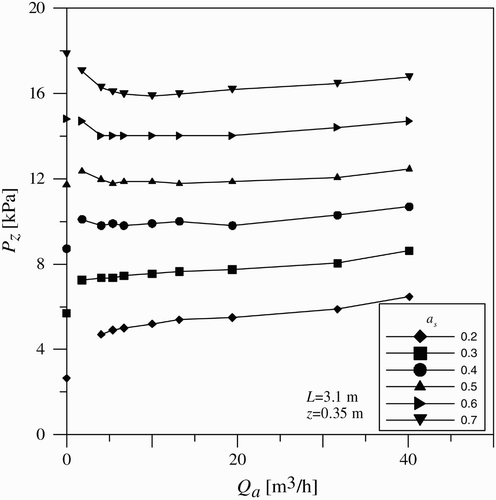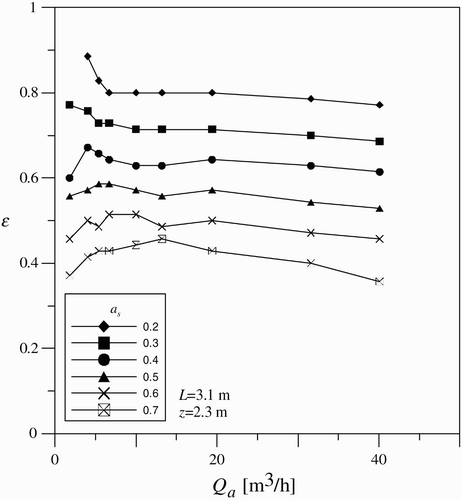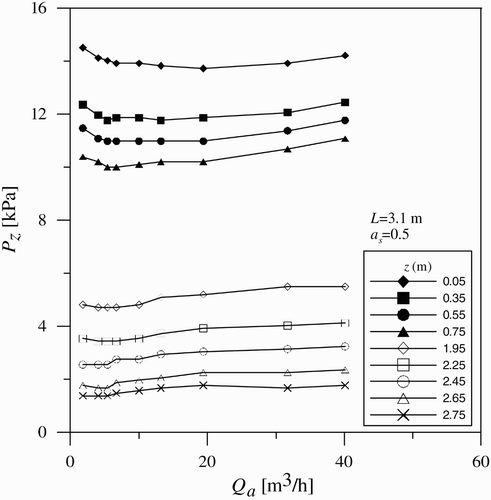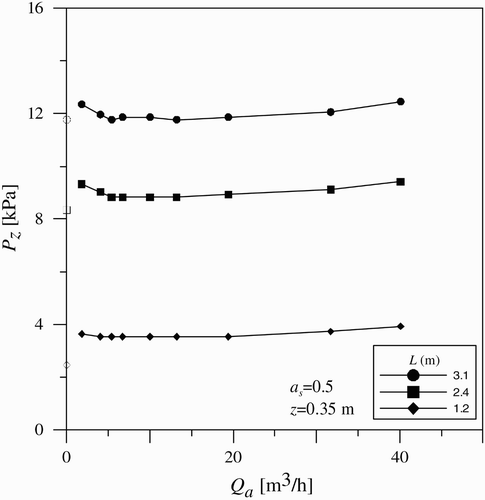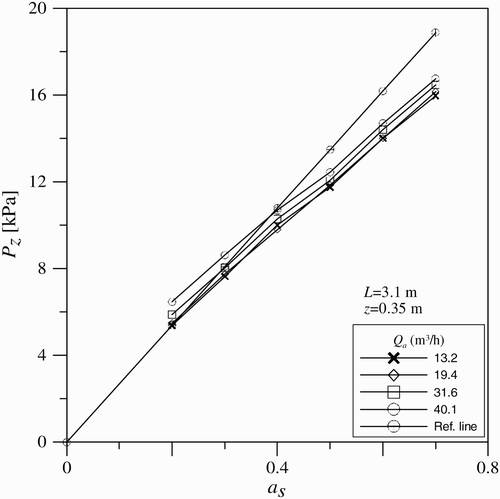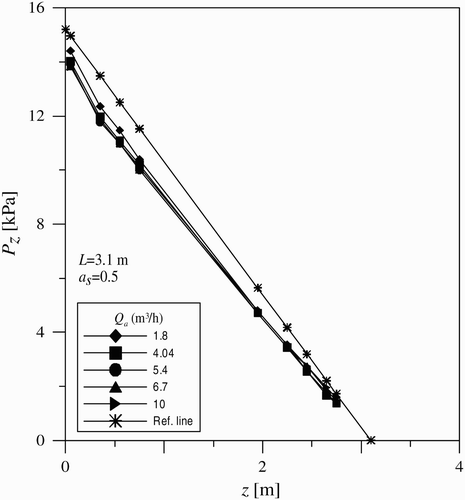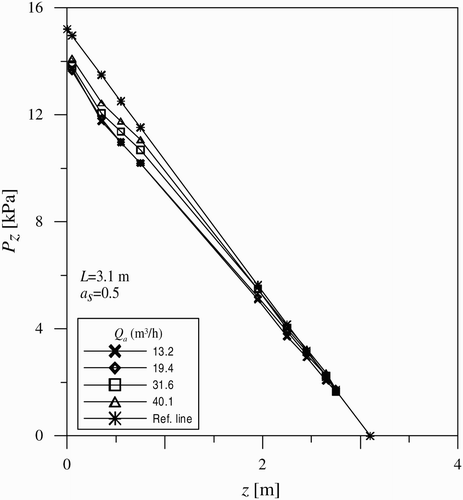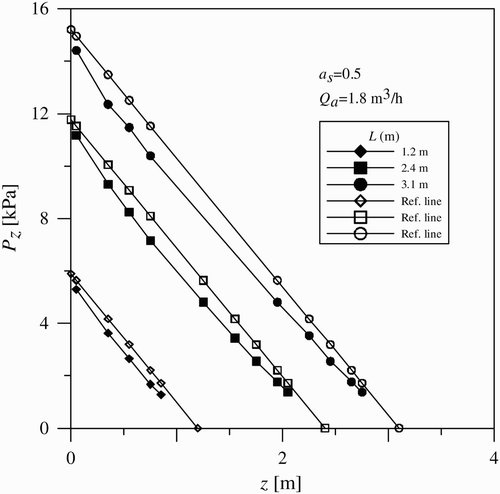Abstract
The pressure behaviour in riser tubes of a short airlift pump was investigated for various submergence ratios, air discharges and riser tube lengths. Two high-frequency response pressure transducers were placed at various positions along the riser tube. The analysis of the recorded pressure signals gave the mean local pressure at specified vertical positions for various submergence ratios, air discharges and riser tube lengths. The experimental data show a non-linear pressure behaviour near the exit of the air ejector due to the increased friction losses in this region. The pressure behaviour for increasing air discharge at a position along the riser tube is related to the corresponding two-phase flow pattern in the riser tube. The pressure distributions along the riser tube for various submergence ratios were compared with the predictions of the Stenning–Martin model.
1 Introduction
An airlift pump corresponds to a vertical tube, i.e. the riser tube or upriser, partly submerged in the liquid to be pumped, near the base of which air is injected. The average density of the two-phase mixture in the upriser is less than the density of the liquid itself thereby causing a pumping action of the liquid. For the two-phase flow of a bubble plume (Bombardelli et al. Citation2007), the same principle is valid, although the flow is then not confined by a pipe as for an airlift flow. Airlift pumps were extensively used in the past to pump deep underground petroleum or water. They have been also used for handling hazardous fluids (e.g. radioactive fluids) because of their simple construction. During their operation, the pumped liquid or slurry is in direct contact with the injected gas. This fact combined with the low shear level encountered in the riser tube makes them attractive for applications in various types of reactors or bioreactors (Garnier et al. Citation1990 or Isaacs and Thomas Citation1992). To reduce CO2 emissions in the atmosphere, airlift installations have been recently proposed for the injection of the exhaust gas from power plants into deep sea-water (Saito et al. Citation2000).
Pressure measurements were used in the past in two-phase flow systems to identify the flow characteristics and the flow structure. Lin and Hanratty Citation(1987) detected the two-phase slug flow pattern from the recorded pressure signals in horizontal pipes of diameters 2.54 and 9.53 cm. Matsui Citation(1986) observed pressure fluctuations in a vertical two-phase flow using differential pressure transducers. His results demonstrated that it is possible to identify the flow pattern from various statistical quantities, including the frequency distribution, the order of variance and the average values of differential pressures and pressure spectra, since these statistical properties depend on the two-phase flow regimes. Hewitt et al. Citation(1963) measured gas hold-up and pressure drop in a two-phase annular flow of a vertical pipe. Their data were compared with the Lockhart and Martinelli Citation(1949) relationships. Akagava et al. Citation(1971) calculated the mean and fluctuating pressure drops along a slug two-phase flow in a vertical tube. To calculate its fluctuating component a Monte-Carlo method was used. They proposed an equation for the fluctuation of the pressure drop and their theoretical results were verified experimentally. Francois et al. Citation(1996) presented two equations predicting the friction loss per unit length of the upriser as a function of void fraction. In both relations, the frictional pressure drop increases with the void fraction. Nemet Citation(1961) proposed a similar relation, indicating also that the frictional pressure drop increases with void fraction. Parker Citation(1980), based on the theoretical model for airlift pumps of Stenning and Martin Citation(1968), determined the total pressure drop between the entrance and the outlet of the riser tube of airlift pumps, for which the pressure drop is a linear function of the length.
For a typical two-phase flow in a vertical tube, the liquid flow is imposed by a pump. For a given airlift pumping system, the liquid flow is exclusively controlled by the imposed air flow, so that the driving force of the two-phase flow in the riser tube is mainly the buoyant force due to the density difference between the liquid and the two-phase mixture. This fact makes the study of two-phase flow in riser tubes an interesting task. Although pressure measurements in these two-phase flows have been extensively studied in the past, a systematic presentation of the pressure along the riser tube as a function of the various operational parameters of the airlift pump is not available yet, except for Morrison et al. Citation(1987), who, among others, presented data of the static pressure along the riser tube of a reverse-circulation airlift pump for two configurations of gas ejector devices. These pressure measurements as a function of various operational parameters are a useful tool for checking the reliability of the various computational models for airlift pumps. From the engineering point of view, the knowledge on the pressure distribution along a riser tube is important, since pressure is one of the main design parameters.
Herein, the pressure behaviour along the riser tube of an airlift pump was studied for various riser tube lengths, air discharges and submergence ratios. Three riser tube lengths of 1.2, 2.4 and 3.1 m were investigated, while the submergence ratio for each riser length was varied between 0.2 and 0.7. The pumping liquid was water and the air discharge varied from 1.8 to 40.1 m3(STP)/h. The measured pressure distributions along the riser tube were compared with these predicted by the Stenning–Martin equation.
2 Experimental facility
shows a sketch of the airlift pump installation investigated herein. It consists of a 3 cm internal diameter (ID) riser tube made of Plexiglas to observe the two-phase flow. The riser tube consists of various tube pieces provided with appropriate flanges. Removing or adding some of these, the riser tube length was adjusted to 1.2, 2.4 and 3.1 m. The riser tube is provided with a conical entrance, 15 cm high and of 10 cm base diameter. The upper end of the conical part is connected to the cylindrical riser tube with flanges, while its base is connected to an intermediate storage tank (). Therein, an air injector can be moved vertically to various positions. The cross-section of the air injector has a diameter of S α = 2.5 cm. At each position of the air injector in the conical entrance, a cross-section of the annulus S w was available for the water to flow into the riser tube during the operation of the airlift pump. The air injector outlet was placed at the entrance of the upriser, so that the ratio was S w /S α = 0.44. The intermediate tank of dimensions 0.42 × 0.42 × 0.30 m3 was connected to the storage tank of dimensions 0.42 × 0.42 × 0.50 m3 via an elastic tube of 5 cm ID. The elevation of the storage tank could be varied mechanically to adjust the submergence ratio of the airlift pump between 0.2 and 0.7. The phase separator tank with a volume of 0.47 × 0.47 × 0.45 m3 was positioned at the riser tube top provided with a water and an air outlet. The separator tank elevation was variable to investigate the operation of the airlift pump for riser tube lengths of 3.1, 2.4 and 1.2 m.
Two pressure transducers (RDP, Model TJE/C683-02) of up to 1000 Hz frequency response were used to measure the instantaneous pressure signals. The riser tubes were provided with appropriate holes at selected z-positions () for mounting the pressure transducers. They were calibrated using water columns of various heights and after the calibration they were placed flat at the inner wall of the riser tube. For each pressure measurement at a specific submergence ratio, air discharge and riser tube length, the two pressure transducers were mounted at two different z-positions, resulting in two simultaneous pressure signals. These two transducers were moved to the remaining z-positions along the riser tube. The sampling rate during the data acquisition was 2000 Hz per channel and the sampling time was 20 s, such that for each measurement 40,000 points per channel were acquired. To digitize the analog signal, a 16 bit DATA TRANSLATION “sample and hold” A/D-converter was used.
Table 1 Positions of pressure transducers above air ejector
The maximum error in the static pressure measurement taking into account errors due to the calibration procedure, to the accuracy of the pressure transducer itself and to the electronics used, was estimated to ±5 Pa.
3 Results and discussion
3.1 Visual observations
The two-phase flow in the riser tube was observed using a high-speed video camera (NAC® Model HSV-400, International IMC Limited, Thame, Oxfordshire, England) with 400 frames/s, in conjunction with a usual video camera Panasonic® S-VHS Camera NV-MS5 with 50 frames/s. The high-speed video camera has a field of view around 10 × 10 cm2 and gives information concerning local flow characteristics. This camera covered a length of about 1 m and rendered mainly macroscopic flow characteristics. The analysis of the video records gave a qualitative picture of the flow under various operational conditions. Visual observations in short riser tubes have been carried out by Tramba et al. Citation(1995).
Four two-phase flow patterns were identified, namely (a) slug flow (b) churn flow (c) wispy annular flow and (d) annular flow (). These flow patterns are similar to those observed in a typical upward two-phase flow in a vertical tube, as described, e.g. in Hewitt Citation(1977). Here, the term “typical upward two-phase flow” relates to a flow where both the liquid and the gas discharges are controlled. Note that independently of the operational conditions, bubbly flow as a fifth flow pattern was never observed in the present study.
Figure 2 Sketch of observed two-phase flow patterns (a) slug flow (b) churn flow (c) wispy annular flow (d) annular flow
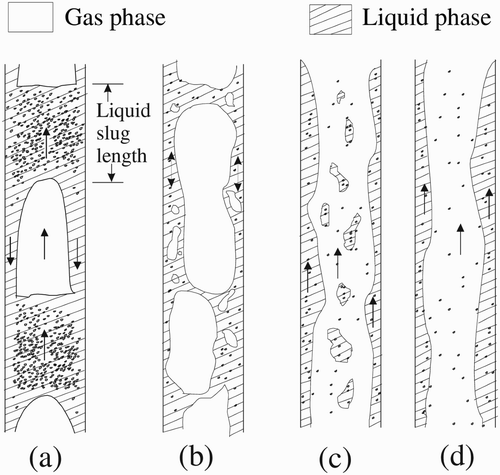
The transitions between the various flow patterns were different from these for a typical upward two-phase flow, since they depend on the submergence ratio and the riser tube length. For example, for submergence ratios of a s = 0.2 and 0.3, the slug flow pattern was not observed. Another characteristic of the airlift flow is that a minimum air discharge is necessary to have a non-zero water discharge from the riser tube outlet (e.g. Lawniczak et al. Citation1999), depending on the submergence ratio for a certain airlift system.
The various flow patterns observed herein are shortly described below together with the air discharges, for which the transitions occur. The slug flow ( is characterized by large bullet-shaped bubbles, i.e. the Taylor bubbles, which are periodically formed. These occupy symmetrically more than 90% of the central pipe part and during their upward movement, a liquid film flows downward along the pipe wall. Taylor bubbles are separated by slugs of liquid, which bridge the pipe and are dispersed with small gas bubbles. The liquid slugs are pushed by the Taylor bubbles upward and during this upward motion a liquid film flows downward, providing the oncoming slug with liquid. For submergence ratios larger than 0.4 and at an air discharge between 4 and 10 m3/h, depending mainly on the submergence ratio, the flow loses its periodicity, the liquid slug becomes more frothy, shorter and disordered and it does not bridge the riser tube. This flow pattern is characterized as churn flow (.
Increasing the air discharge above some 20 m3/h, corresponding to a superficial gas velocity of around 7 m/s, the churn flow character reduces gradually and the gas phase occupies almost entirely the central riser tube portion in which relatively large liquid lumps or wisps move upward (. This is wispy annular flow. For air discharges larger than around 30 m3/h, i.e. superficial gas velocities >12 m/s, annular flow is generated of which the central part of the riser tube is constantly occupied by the gas phase dispersed with small drops while a thin wavy liquid film at the tube wall moves upward (.
The airlift flow patterns including the transitions were also investigated using the signals from a point conductivity probe placed appropriately in the riser tube. These probes have been extensively used in turbulent mixing and two-phase flow studies (e.g. Alonso Citation1971, Chua et al. Citation1986, Ncube et al. Citation1991). Simultaneous point conductivity measurements in two-phase flows allow the various flow characteristics to be evaluated as gas void fraction or liquid slug length.
3.2 Pressure measurements
shows the measured mean-static pressure as a function of air discharge at z = 0.35 m for a riser tube length of L = 3.1 m. Each curve corresponds to a discrete submergence ratio between 0.2 and 0.7. The mean pressure at z = 0.35 m is observed to increase with the submergence ratio. This is expected since the submerged part of the riser tube increases with the submergence ratio and consequently the corresponding mean static pressure. The symbols on the pressure axis denote the static pressure at z = 0.35 m if the airlift pump is not in operation (Q a = 0 m3/h). These points are calculated from P zi = ρ w g(H s −z) = ρ w g(La s −z). This equation gives the static pressure at a position z due to the liquid column between z = H s and the considered position z and it is valid for z < H s = a s L. Position z = 0 is located at the exit of the air ejector. A characteristic of the curves in is that for submergence ratios larger than 0.4, the pressure first decreases for air discharges between 4 and 10 m3/h, depending on the submergence ratio, and then slightly increases for higher discharges. A qualitatively similar behaviour shows also the curves P z = f(Q a ) for other z-positions not presented here. For the submergence ratios 0.2 and 0.3, the local mean-static pressure P z increases monotonically with air discharge. Note the transition slug/churn occurs for air discharges between 4 and 10 m3/h.
To understand the pressure behaviour of , the static pressure above z = 35 cm was considered. For the vertical two-phase flow in a vertical straight pipe of constant diameter and a definite pipe length, the friction term is in general negligible compared with the static term. The static term P z is proportional to the two-phase mixture density ρ M above the considered position z = 0.35 m, P z = ρ M g(L−z). The mixture density in turn depends on the gas void fraction ϵ as given by ρ M = ρ w (1−ϵ).
The interpretation of the pressure behaviour for various operational conditions requires knowledge of the void fraction at various locations above the air ejector. Such a location was selected at z = 2.3 m. The differential pressure method was used to measure the void fraction ϵ (Ma et al. Citation1991). This method involves a vertical upward two-phase flow in a tube, such that the pressure drop ΔP along the tube mainly results from the static pressure difference between two locations, neglecting the pressure drops due to friction losses and due to acceleration of the mixture. For a typical vertical upward two-phase flow with a velocity of around 1 m/s, and considering the energy balance between two positions along the riser tube, the friction and acceleration terms are confined to less than 2% of the static term, under the assumption that the gas weight is negligible as compared with the water weight. Under these assumptions, the relation for void fraction ϵ is (Neal and Bankoff Citation1963)
The pressure decrease P z for Q a < 4 to 10 m3/h and a s ≥ 0.4 is seen to be the result of the mixture density decrease above z = 0.35 m, since the corresponding void fraction in increases with air discharge. For Q a > 10 m3/h and a s ≥ 0.4, the void fraction slightly decreases with air discharge thereby causing an increase of the corresponding mixture density above z = 0.35 m and, consequently a slight increase of static pressure with the air discharge as observed in . For a s = 0.2 and 0.3, the void fraction in decreases with the air discharge (the mixture density is an increasing function of it), justifying thereby the pressure increase with the air discharge for these submergence ratios in .
To propose a physical explanation of and , consider a sequence of phenomena taking place during pumping under various submergence ratios. First an airlift pump operating at a low submergence ratio, e.g. a s = 0.3 is considered. For Q a = 0, the length of the liquid column above the ejector is Δz = La s = 3.1 × 0.3 m = 0.93 m. As air injection starts, this liquid column has to cover a vertical distance of Δz′ = L−La s = (3.1−3.1 × 0.3) m = 2.17 m, which is relatively long for a liquid slug to reach the riser tube top. Visual observations of the two-phase flow at this low submergence ratio indicated that as the air injection starts, the liquid slugs propagate upward, associated with a liquid film flowing downward, ( rendering a shorter liquid slug. For low submergence ratios, the liquid slug is penetrated by the oncoming air bubble and all its liquid is swept by the oncoming liquid slug. This sequence of events can occur five to six times until a liquid slug is provided with enough liquid, so that it reaches the top of the riser tube. In other words, during pumping under low submergence ratios, liquid is accumulated in the riser tube until a liquid slug leaves the riser tube. This water accumulation in the riser tube causes an increase of the mean static pressure with increasing air discharge. This pressure behaviour is observed in for a s = 0.2 and 0.3.
For high submergence ratios, e.g. a s = 0.7, Δz above the air ejector for Q a = 0 is Δz = La s = 3.1 × 0.7 m = 2.17 m. As gas injection starts, a liquid slug has to cover a vertical distance of Δz′ = L−La s = 3.1−3.1 × 0.7 m = 0.93 m. As was visually observed, for this relatively short length Δz′, it is possible for a liquid slug to reach the top of the riser tube without being penetrated by the oncoming air. The air injection in the liquid column causes a decrease of the static pressure and an increase of the void fraction, as shown in and , for a s = 0.7, respectively.
shows the mean local pressure as a function of air discharge for various z-positions, a s = 0.5 and L = 3.1 m. The pressure decrease shown in for a s = 0.5, i.e. for low air discharges followed by increasing pressure for higher air discharges, is seen to be valid up to a height of about 2 m. Beyond this height, pressure increases with the air discharge. The reason for the pressure behaviour for lower z (herein z ≤ 0.75 m) is the same as discussed above for . As was concluded from diagrams similar to , the void fraction decreases with air discharge at higher z (higher than about 2 m in ), which means a corresponding pressure increase with the air discharge.
shows the pressure at z = 0.35 m as a function of air discharge for a s = 0.5 and three riser tube lengths L = 3.1, 2.4 and 1.2 m. All curves have the same behaviour as the curve in for a s = 0.5, i.e. for low air discharge, a decrease of the local mean pressure with the air discharge and a slight increase otherwise, indicating similar flow patterns in the three riser tubes.
shows the local mean pressure at z = 0.35 m as a function of submergence ratio for air discharges Q a ≤10 m3/h. The curve based on P zi = ρ w g(H s −z) = ρ w g(La s −z) is taken as the reference line. For this air discharge region, all measured pressure curves lie below the line, because the measured pressures involve friction losses.
Figure 7 Mean pressure versus submergence ratio for low air discharges Q a ≤10 m3/h and L = 3.1 m for z = 0.35 m

The curves in differ from those of in the air discharge region, i.e. they refer to Q a > 10 m3/h. The curves corresponding to Q a = 31.6 and 40.1 m3/h and submergence ratios 0.2 and 0.3 lie above the reference curve. A possible explanation of this behaviour arises by taking into account , where for a height of z = 2.3 m (above the considered position z = 0.35 m), the void fraction decreases with z for a s = 0.2 and 0.3. Consequently, for these low submergence ratios and z = 0.35 m, the two-phase mixture density is higher than the mean density ρ M = ρ w a s considered for the reference curve Pzi = f(z) in . The measured static pressure is thus higher than the static pressure corresponding to the reference line.
shows the pressure distribution along the riser tube of length L = 3.1 m for low air discharges up to 10 m3/h and for a s = 0.5. The reference line is again drawn. For all air discharges, the corresponding curves are seen to lie below this line. For increasing air discharges there is a slight displacement of the curves downward. The deviation of the measured curves from the reference curve is a measure of non-uniformity of the two-phase mixture above the considered z-position and of friction losses from the entrance of the riser tube to the considered z-position.
For a constant z < 1 m (), the measured P z slightly decreases if Q a increases from 1.8 to 4.04 m3/h. This behaviour can be understood from the curve for a s = 0.5 in and for air discharges in this region. The void fraction slightly increases with Q a and consequently ρ M = ρ w a s decreases, possibly causing a corresponding decrease of P z with Q a . The other curves which correspond to higher air discharges almost collapse.
In , the pressure distributions along the riser tube are shown, as in , this time though for Q a > 10 m3/h. As shown in , for Q a > 10 m3/h, a s = 0.5 and for increasing air discharge, void fraction decreases. Consequently, the mixture density above the considered z-position increases with Q a so that the measured static pressure increases. This is the reason for the upward shifting of the measured curves P z = f(Q a ) for increasing Q a approaching eventually the reference line.
Observing the curves in and , it can be seen that for z-distances near the entrance of the riser tube, the deviation of the experimental curves from the reference line is larger than for larger z. This behaviour is expected since near the riser tube entrance, where the air is injected, the friction losses are increased, causing a higher pressure drop as compared with the other parts of the riser tube.
shows the pressure distribution along the three considered riser tube lengths. The air discharge was held constant at 1.8 m3/h (in the slug flow region) and a s = 0.5. The reference lines are also drawn. For a s = 0.5, the submerged tube length increases with the riser tube length, so that the static pressure at a z position increases also with the riser tube length. This is the reason why the curve corresponding to 3.1 m riser length in lies above the other curves. Similarly, the curve for the 2.4 m riser length lies above the curve for 1.2 m length. The reference curves are seen to be close to the measured pressure distributions. The deviation of the measured pressure curves from the reference line is a measure of both the friction losses and the density non-uniformity of the two-phase mixture. It is obvious from all these curves that the deviation between the measured pressures and the reference line is less than 8–10% of the local pressure. Consequently, the maximum friction losses are less than this percentage.
During the operation of the airlift pump, the pressure at the riser tube exit is normally constant and close to the atmospheric, independent of geometrical and operational characteristics. Consequently, the airlift system reacts if an operational parameter is changed in such a way that the pressure at the exit becomes atmospheric. This is done by reducing or increasing the liquid discharge for a given air discharge or by changing appropriately the structure of the two-phase flow and consequently the friction losses, the void fraction or other parameters so that the boundary condition at the riser tube exit is satisfied.
3.3 Comparison with the Stenning–Martin equation
Applying the energy balance between the entrance with pressure P E and the outlet with atmospheric pressure P a of the riser tube of diameter D gives the Stenning–Martin equation as
The first term on the right-hand side expresses the friction losses along the riser tube, while the second term is an expression of the static pressure of the two-phase mixture in the riser tube. The slip factor s is equal to the ratio of the air superficial velocity V a to the water superficial velocity V w , taking values between 1.5 and 2 (Stenning and Martin Citation1968). The friction factor f is calculated by considering only the liquid phase of volumetric discharge Q w + Q a .
Considering a position z along the riser tube instead of the entrance position E, the pressure distribution along the riser tube is given by
Figure 12 Comparison of pressure distribution along the riser tube for a s = 0.4 with Stenning–Martin model
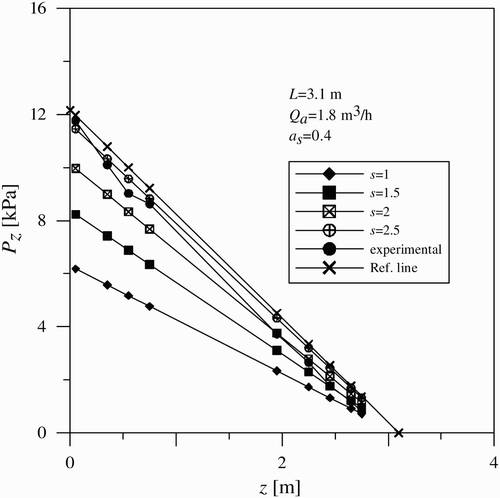
and show the pressure distributions along the riser tube as in , for a s = 0.5 and 0.7, respectively. The air discharge is the same as in , whereas Q w = 0.775 and 1.729 m3/h, respectively. In , for a s = 0.5 minimum deviations from the experimental curve occur for s = 1.5, whereas for a s = 0.7 in minimum deviations occur for s = 1. This behaviour is expected since the slip factor s = V a /V w , which in turn is equal to Q a /Q w , i.e. s = V a /V w = Q a /Q w . It is well known for airlift pumps that for a certain Q a (herein 1.8 m3/h), Q w increases with a s . Consequently, for increasing the submergence ratio the slip factor decreases, since the water discharge in the denominator increases. It is expected that in for a s = 0.4, the predictions of the Stenning–Martin model for high values of s = 2.5 should compare well with the test data. For a higher submergence ratio a s = 0.5, and for the same air discharge, a higher water flow is related and consequently a lower slip factor of s = 1.5 is expected to verify the experimental data (). The same is true in , where s = 1 compares well with the test data corresponding to a s = 0.7.
Figure 13 Comparison of pressure distribution along riser tube for a s = 0.5 with Stenning–Martin model
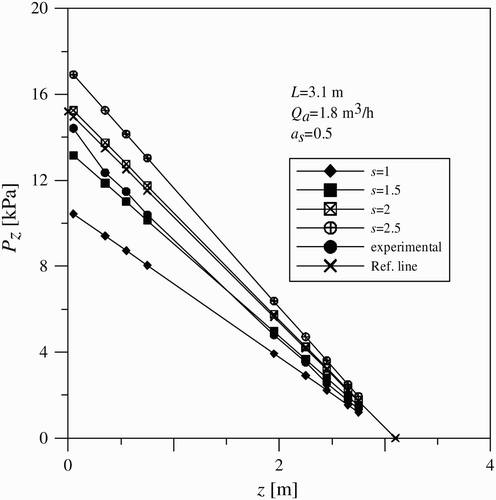
Figure 14 Comparison of pressure distribution along the riser tube for a s = 0.7 with Stenning–Martin model
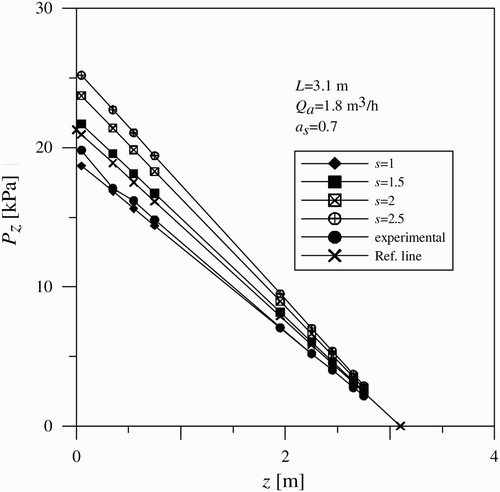
The calculated reference pressure distribution lies in all cases () close to the measured data. The reference line, as mentioned in Section 3.2, gives the static pressure at a position z due to the liquid column between z = H s and the considered position z, without account for friction loses. The fact that the measured pressure in all cases lies close to the reference line indicates that the pressure drop due to friction losses under the operational conditions and geometrical characteristics is only a small portion of the local static pressure.
This study refers to airlift pumps of short length with three lengths investigated. For these, the pressure along the riser tube behaves in a similar way, as shown in and . The results can be extrapolated to real airlift systems of short length and their design. For long riser tube airlift systems, where the injected gas is compressed, the flow phenomena can be different and consequently the pressure behaviour too.
4 Conclusions
This study is a systematic presentation of the pressure behaviour in riser tubes of an airlift pump for various submergence ratios, air discharges, riser tube lengths and z-positions along the tube. The pressure behaviour at a certain position involves the static pressure due to the two-phase mixture above the considered position. The pressure distribution along the riser tube is predicted by the Stenning–Martin equation if the slip factor for low submergence ratios is substituted by relatively high values, and for high submergence ratios by low values. The small deviation of the reference curve, corresponding to frictionless and uniform mixture density, from the measured pressure values along the riser tube indicates the minor role of friction on the pressure drop compared with the static pressure for the investigated airlift pump.
Notation
| D | = |
inner diameter of riser tube (m) |
| f | = |
Fanning friction factor |
| g | = |
gravitational acceleration (m/s2) |
| H l | = |
riser tube length above water level (m) |
| H s | = |
submerged riser tube length (m) |
| L | = |
riser tube length (m) |
| P z | = |
pressure at position z (Pa) |
| P a | = |
atmospheric pressure (Pa) |
| P E | = |
pressure at riser tube entrance (Pa) |
| Pzi | = |
pressure at z with negligible friction losses (Pa) |
| Q a | = |
air discharge (m3/s) |
| Q w | = |
water discharge (m3/s) |
| s | = |
slip factor |
| S a | = |
air ejector cross-section (m2) |
| S w | = |
cross-sectional area for water entrance (m2) |
| V a | = |
superficial air velocity (m/s) |
| V w | = |
superficial water velocity (m/s) |
| z | = |
position along riser tube (m) |
Greek symbols
| a s | = |
submergence ratio (m/m) |
| Δz, Δz′ | = |
vertical distance (m) |
| ΔP | = |
pressure difference (Pa) |
| ΔP T | = |
pressure drop between entrance and outlet of riser tube (Pa) |
| ϵ | = |
void fraction |
| ρ w | = |
water density (kg/m3) |
| ρ M | = |
mixture density (kg/m3) |
References
- Akagava , K. , Hamaguchi , H. , Sakaguchi , T. and Ikari , T. 1971 . Studies on the fluctuation of pressure drop in two-phase slug flow . Bull. JSME. , 14 ( 71 ) : 455 – 461 .
- Alonso , C. V. 1971 . Comparative study of electrical conductivity probes . J. Hydraulic Res. , 9 ( 1 ) : 1 – 10 .
- Bombardelli , F. A. , Buscaglia , G. C. , Rehmann , C. R. , Rincon , L. E. and Garcia , M. H. 2007 . Modelling and scaling of aeration bubble plumes: A two-phase flow analysis . J. Hydraulic Res. , 45 ( 5 ) : 617 – 630 .
- Chua , S. K. , Cleaver , J. W. and Millward , J. M. 1986 . The measurement of salt concentration in a plume using a conductivity probe . J. Hydraulic Res. , 25 ( 3 ) : 171 – 178 .
- Francois , O. , Gilmore , T. , Pinto , M. and Gorelick , S. 1996 . A physically-based model for air-lift pumping . Water Resour. Res. , 32 ( 8 ) : 2383 – 2399 .
- Garnier , A. , Chavarie , C. and Klvana , D. 1990 . The inverse fluidization airlift bioreactor I: Hydrodynamic studies . Chem. Eng. Commun. , 98 ( 1 ) : 31 – 45 .
- Hewitt , G. F. 1977 . “ Flow patterns ” . In Two-phase flow and heat transfer , Oxford, , UK : Oxford University Press . 2, 18–39
- Hewitt , G. F. , King , I. and Lovegrove , P. C. 1963 . Holdup and pressure drop measurements in the two-phase annular flow of air-water mixtures . Br. Chem. Eng. , 85 ( 5 ) : 311 – 318 .
- Isaacs , S. H. and Thomas , M. 1992 . The adaptive control of an airlift tower loop fermenter . Chem. Eng. Sci. , 47 ( 4 ) : 943 – 958 .
- Lawniczak , F. , Francois , P. , Scrivener , O. , Kastrinakis , E. G. and Nychas , S. G. 1999 . The efficiency of short airlift pumps operating at low submergence ratios . Can. J. Chem. Eng. , 77 ( 1 ) : 3 – 10 .
- Lin , P. Y. and Hanratty , T. J. 1987 . Detection of slug flow from pressure measurements . Int. J. Multiph. Flow. , 13 ( 1 ) : 13 – 21 .
- Lockhart , R. W. and Martinelli , R. C. 1949 . Proposed correlation of data for isothermal two-phase, two component flow in pipes . Chem. Eng. Prog. , 45 ( 1 ) : 39 – 48 .
- Ma , Y-P. , Chung , N-M. , Pei , B-S and Hsu , Y-Y. 1991 . Two simplified methods to determine void fractions for two-phase flow . Nucl. Tech. , 94 ( 1 ) : 124 – 133 .
- Matsui , G. 1986 . Automatic identification of flow regimes in vertical two-phase flow using differential pressure fluctuations . Nucl. Eng. Des. , 95 ( 8 ) : 221 – 231 .
- Morrison , G. L. , Zeineddine , T. I. , Henriksen , M. and Tatterson , G. B. 1987 . Experimental analysis of the mechanics of reverse circulation air lift pump . Ind. Eng. Chem. Res. , 26 ( 2 ) : 387 – 391 .
- Ncube , F. , Kastrinakis , E. G. , Nychas , S. G. and Lavdakis , K. E. 1991 . Drifting behaviour of a conductivity probe . J. Hydraulic Res. , 29 ( 5 ) : 643 – 654 .
- Neal , L. G. and Bankoff , S. G. 1963 . A high resolution resistivity probe for determination of local void properties in gas-liquid flows . AIChE J. , 9 ( 4 ) : 490 – 494 .
- Nemet , G. A. 1961 . Flow of gas-liquid mixtures in vertical tubes . Ind. Eng. Chem. , 53 ( 2 ) : 151 – 154 .
- Parker , G. J. 1980 . The effect of footpiece design on the performance of a small air lift pump . Intl. J. Heat Fluid Flow. , 2 ( 4 ) : 245 – 252 .
- Saito , T. , Kajishima , T. and Nagaosa , R. 2000 . CO2 sequestration at sea by gas-lift system of shallow injection and deep releasing . Envron. Sci. Technol. , 34 ( 19 ) : 4140 – 4145 .
- Stenning , A. H. and Martin , C. B. 1968 . An analytical and experimental study of air lift pump performance . ASME, J. Eng. Power A. , 90 ( 2 ) : 106 – 110 .
- Tramba , A. , Topalidou , A. , Kastrinakis , E. G. , Nychas , S. G. , Francois , P. and Scrivener , O. 1995 . Visual study of an airlift pump operating at low submergence ratios . Can. J. Chem. Eng. , 73 ( 5 ) : 755 – 764 .

